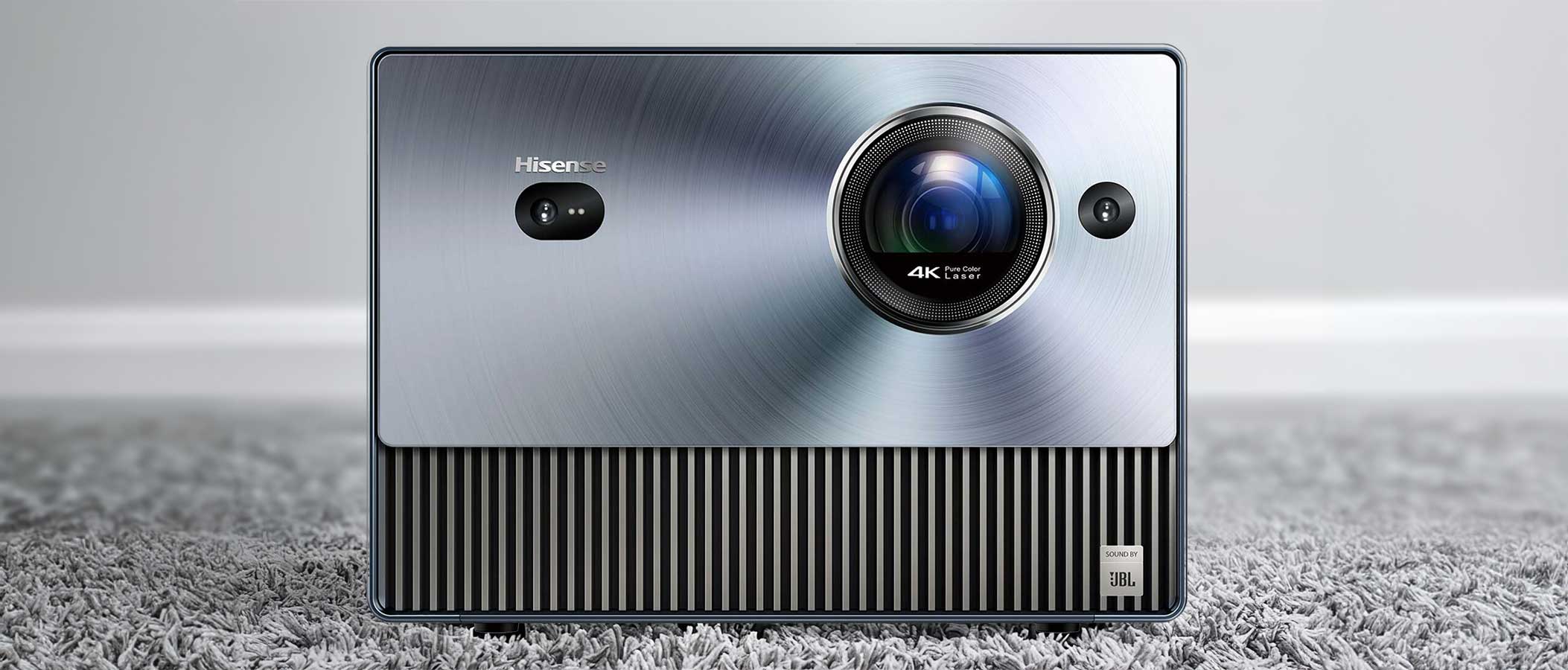Sound+Image Verdict
The C1 proved a versatile small (if not quite mini) projector, marked out by its premium build quality, smart streaming and overall solid image performance at the price.
Pros
- +
Premium solid construction
- +
VIDAA interface & streaming
- +
Automagic set-up & sound options
- +
Good motion handling
- +
OK against ambient light…
Cons
- -
…though best-quality images come after dark
- -
Some signals arrived via VIDAA in HD only
Why you can trust What Hi-Fi?
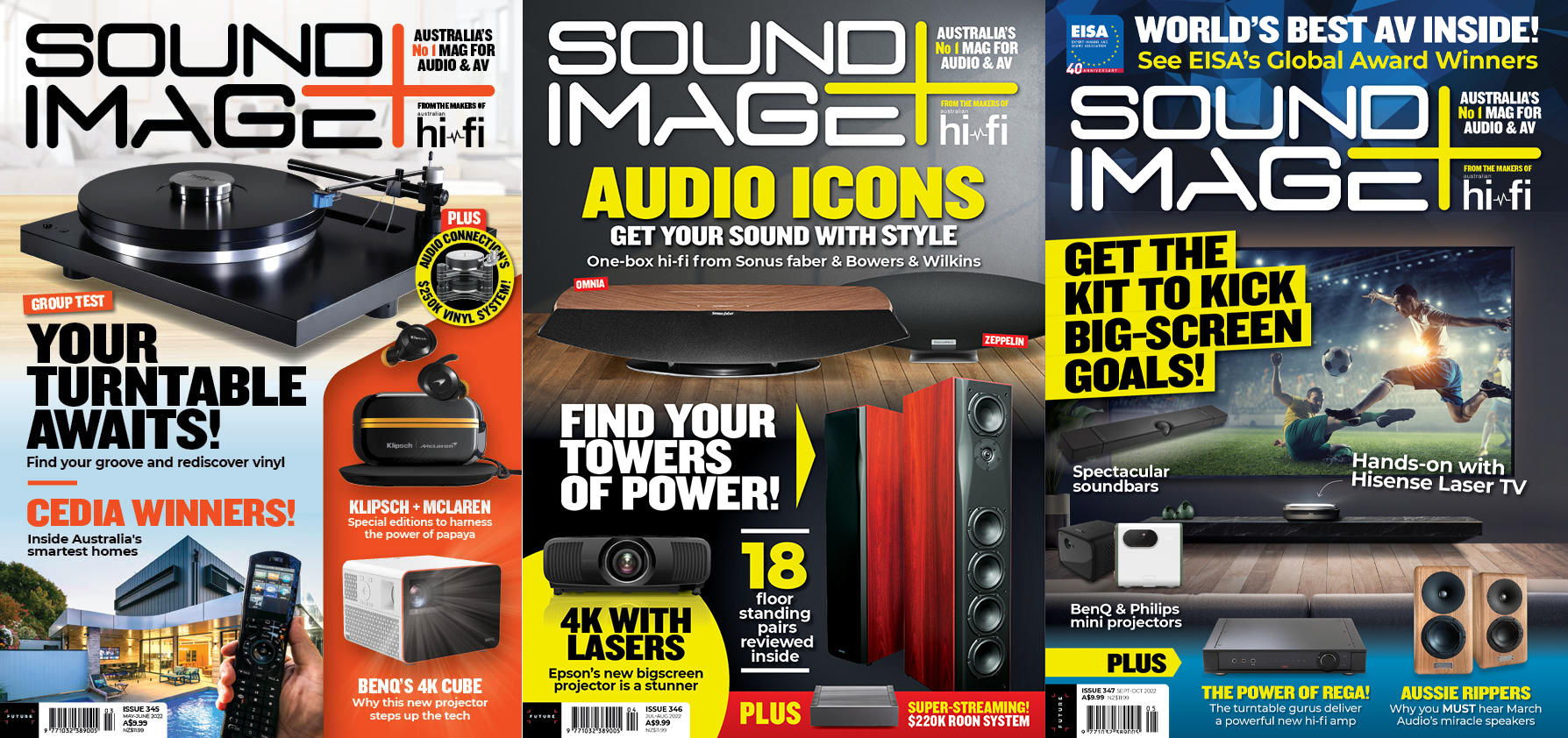
This review originally appeared in Sound+Image magazine, Australian sister publication to What Hi-Fi?. Click here for more information on Sound+Image, including digital editions and details on how you can subscribe. Read the What Hi-Fi? team's global, star-rated Hisense C1 review.
Hisense terms the C1 a TriChroma Laser Mini Projector – but we reckon only half of that description is accurate. It’s certainly got trichroma lasers, which we’ll come to shortly. But it’s understating the case to call it ‘Mini’, because it’s really moderately large and long-throw, and an understatement also to call it merely a projector, because the C1 brings more than mere projection to the party. It’s got built-in smarts, both in easing the set-up with near-instant calibration and in providing a smart interface with access to streaming media. And it’s got built-in speakers,
so your sound system is also covered.
In fact with the C1, Hisense seems to be taking almost everything that has made such a success of its larger near-screen ultra-short-throw ‘Laser TV’ designs and then squeezing it all into this smaller (if-not-quite-mini) projector.
Projection expectations
It’s worth remembering that Hisense has come to projectors from its global success in televisions. This shows. Its ultra-short-throw projectors were the first to add TV tuners along with TV-style smart interfaces and speakers; these ‘Laser TVs’ are designed to replace your TV.
The C1 is the same, other than lacking a TV tuner here, which makes sense given that a projector like this is less likely to be conveniently situated near an antenna socket, and indeed Hisense seems to expect it to be used ‘ad hoc’ around the home. The Australian literature also says that the C1 has been “specifically engineered for the Australian market”, despite the C1 being a global product launched earlier in the Chinese home market. When we queried this we were told it is “perfectly suited to the open floor plans common in modern Australian homes”. Which is certainly true.
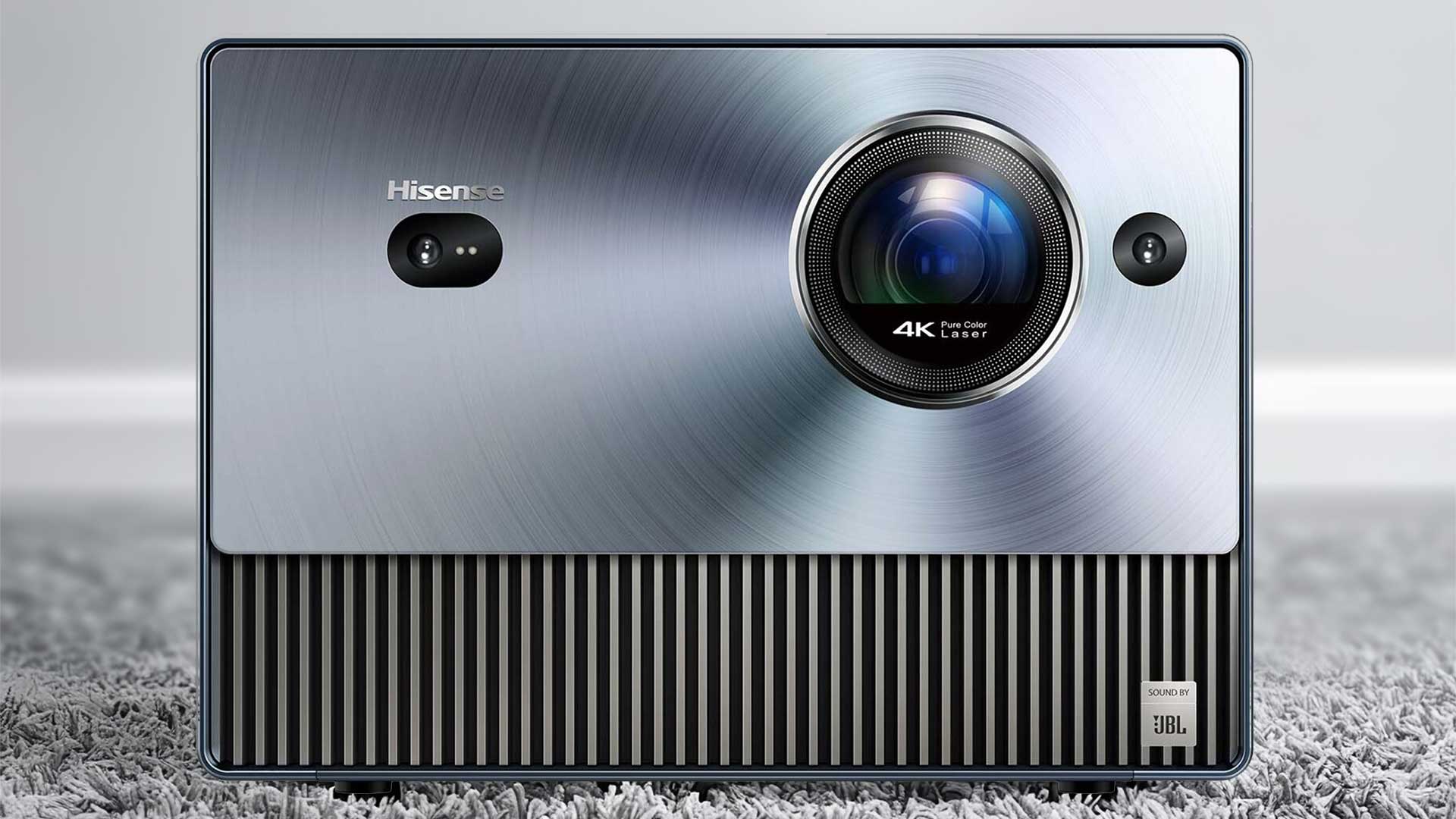
Projection type: DLP XPR (4 x 1920x1080 = 3840 x 2160)
Light source: three-colour laser
Screen size: 65 to 300 inches
Inputs: 2 x HDMI (one eARC), USB-A 2.0, USB-A 3.0, Ethernet
Outputs: HDMI eARC, minijack analogue out, optical digital out
Dimensions (wdh): 245 x 216 x 179mm
Weight: 4.6kg
Wherever you do decide to put the C1, its distance from the wall will depend entirely on your desired screen size. Hisense quotes it as offering from a 65-inch diagonal image to a massive 300-inch diagonal, and distance to the screen is slightly further than the desired diagonal.
So the C1 needs to sit 68 inches away for a 65-inch image, and up to 317 inches for 300 inches, and that’s eight metres, which is a pretty giant room.
We all want a big screen, of course, but the other trade-off for screen size is brightness: the same brightness has to fill the ever-expanding screen size. That’s further affected by ambient light conditions, should you be planning to use your projector during daylight hours or in a room with some lighting, rather than in a darkened dedicated room.
The brightness from the C1 is rated at 1600 ANSI lumens from its three laser light sources, individually providing the red, blue and green parts of the image, while the DLP projection system uses pixel-flipping of a native full-HD digital micromirror device in order to deliver a wobulated 3840 × 2160 (4K) resolution on the screen. We gather that this lumens measurement is typically done in standard mode where colour temperature is 10000K; for a warmer colour balance of 6500K it might be around 1300 ANSI lumens.
Hisense says that this level of brightness means “you can get a great picture quality with just enough brightness for indoor rooms with medium ambient light”, but without relating that to a screen size; we’re fairly sure that wouldn’t be the case with a 300-inch screen, but yes, when filling our 100-inch screen that was a reasonable description, and the C1 proved itself well enough for casual use in this environment. We enjoyed faded movies during the day with varying ambient light, while at night, the C1 proved itself an able full-sized projector. There is the additional advantage of a longer throw that you get fewer of the screen anomalies that can occur with high-lumen close-up projection, such as hot spotting.
For many users much viewing material may come directly from the VIDAA interface which pops up when you press the Home (house icon) button. VIDAA (here in version 7.0, we think) doesn’t even get a name-check in the Quick Start Guide so you’re on your own to work it out, but happily it’s pretty intuitive, with an excellent interface, logically laid out, snappy in use, and packed with apps from which to stream content. Some are pre-loaded; others require a quick search and install process from the VIDAA Apps section.
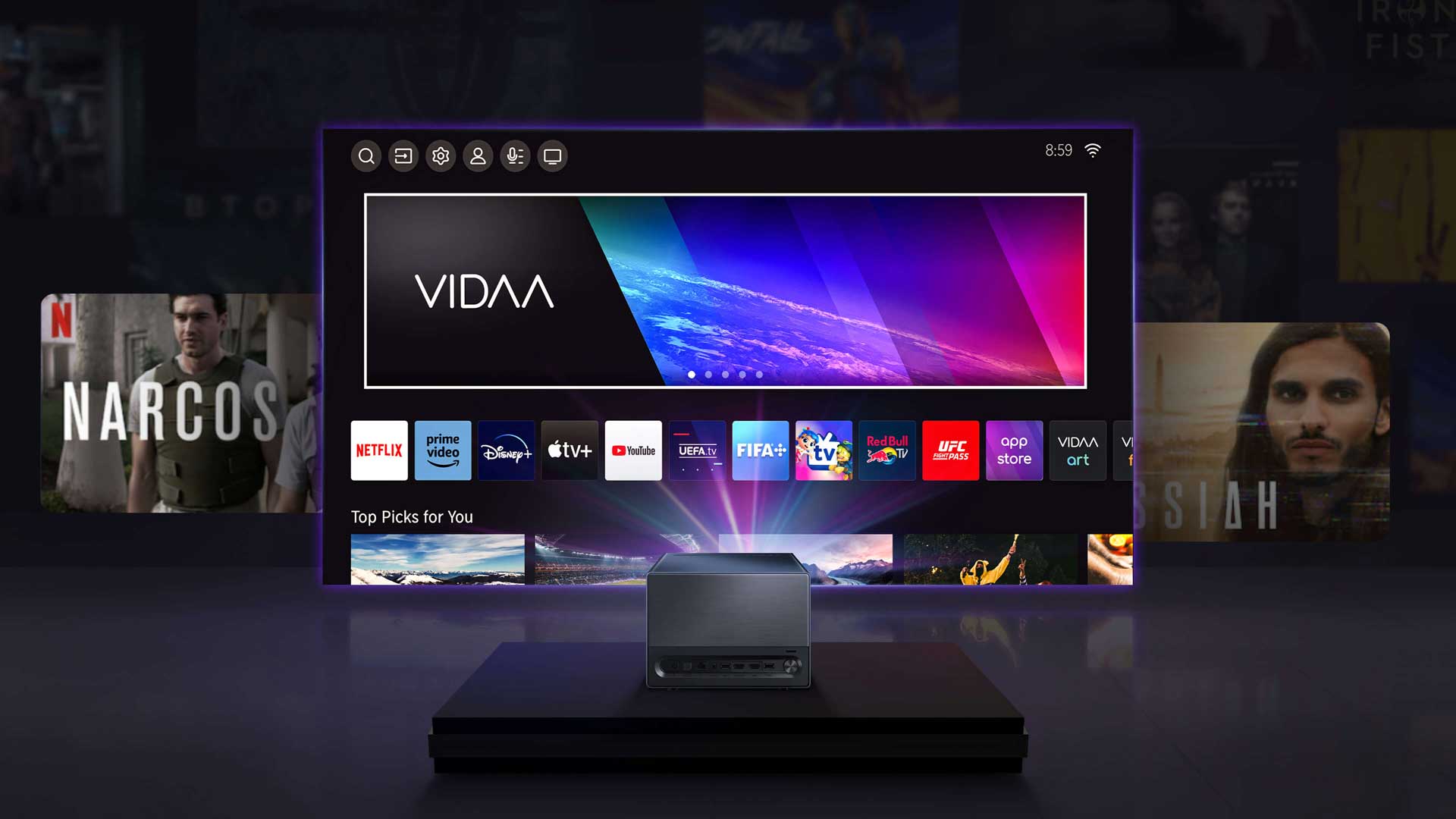
The main VIDAA app store covers all major paid streaming providers we could think of (including Netflix, Kayo Sports and Foxtel Now), three of the five terrestrial catch-up app services (no 7plus or 10play at the time of testing), and then a great many assorted extras from useful likes of Tubis, music streamers, and Bolt+, this last requiring separate sign-up to access a whole other ecosystem of “social TV”, some independent, but also news services and Premier League club channels (though not matches). There’s not quite the massive range of Google’s store, so you can’t rely on some specialised tech app being available, but it certainly covers all genres, and you’ll never want for something to explore.
There’s also a VIDAA Art section should you wish to leave your projector blazing away showing pictures when you’re not using it – this feature is perhaps rather more relevant to Hisense TVs, which also get ‘VIDAA Channels’, not included here at all, perhaps because in the TVs they're on the channel list, and there’s no channel list here.

Build & facilities
It’s a well-built unit, the C1 (known as Cube C1 in some markets), with black anodised aluminium wrapping around the four sides, lens pointing to the front, connections to the rear. These include two HDMI inputs, one supporting eARC audio output so presumably 2.1 spec, the other accepting up to UHD/60, so probably HDMI 2.0. You also get an unusual HDMI dongle-like device in the box, which turned out to be a little extender, just in case you have a chunky HDMI cable or dongle which is hard to get into the sockets on the unit itself – very helpful, thank you!
There are two USB-A slots, one USB 2.0 and the other 3.0, but nothing in the Quick Start Guide about what or whether these can play files. The Quick Start Guide does refer you to an ‘E-manual’, which is not yet (July '24) on the Australian Hisense site, but which is actually embedded in the projector’s memory, so you can read it, slightly inconveniently, on screen. We also tracked down a PDF version on the Hisense USA site, which was far easier! This full guide is essential to understanding and using this projector, and ideally would be supplied or more clearly linked in the box. And it confirmed that the USB sockets can not only play video and music, they can do so at up to 4K/120 video for some formats.
That HDMI eARC socket is just one of several options for getting sound out of the C1 and into a sound system: there are two more, with a minijack analogue audio output and an optical digital audio output. These will be very handy for anyone in a semi-permanent installation, and are often lacking on many rivals, so bonus points here.

But you don't need to add a sound system for ad hoc use; a built-in sound system forms part of the attractive frontage, the top half a sturdy plastic marked with concentric rings extending out from the lens position beyond the Hisense logo and the twin camera apertures that are used for auto-calibration and object avoidance. Below is an equally sturdy grille marked with “Sound by JBL”, who have overseen or tuned the sound system.
This all shows once again how Hisense has moved beyond any origin as a ‘budget’ Chinese brand. Hisense uses ‘Premium’ as part of the product tag here, and construction certainly feels a level above most other products sold as ‘mini’ projectors.
How mini is it, though? It’s only a few percentage points smaller (and a half kilo lighter) than than one of our main projector winners in the recent Sound+Image awards, Xgimi’s identically-priced Horizon Ultra, which we’ve never considered to be ‘mini’. Both Ultra and C1 are certainly smaller than many a full-size conventionally-shaped home cinema model that might offer 3000 lumens and up (Xgimi’s Ultra claims 2300 lumens and did prove significantly brighter), but the C1 is nevertheless significantly bigger than the likes of BenQ’s 4K X300G cube, for example, while real mini projectors like Xgimi’s Mogo Pro or Samsung’s Freestyle are far more compact – but are far more limited in both lumens and resolution.
So the Hisense sits somewhere inbetween: it requires a two-hand lift, rather than being entirely portable, but is easily moved around the home for impromptu use, rather than requiring a full and permanent installation.
AutoMagic AI set-up
And for ad hoc installation it is immeasurably assisted by its AutoMagic AI set-up. This fully automates focus, keystone and screen alignment, and also watches permanently with cameras to spot obstacles, or people or pets who might need their eyes protected (although the eye protection was defaulted to ‘off’ in the model which came to us).
AutoMagic AI is always ready – nudge the C1 slightly out of position during use and the calibration screen pops up to interrupt your viewing while it puts everything to rights again in a quick 5-10 second process.
We noted that the AutoMagic AI doesn’t work at all above 150-inch screen sizes – manual focus and keystone will be required there. Indeed the AutoMagic AI is very quick to fix things up, but it’s always best to minimise any corrections required, especially for keystone, which reallocates all your pixels and eats into your resolution. So for your best picture, get things as on-axis as possible.

Performance
So we played with AutoMagic to see how it handled off-axis positions, and the auto-calibration certainly worked, and worked well, throwing up a big white screen of blocks, adjusting screen shape and presumably contrast. But for best results we lined it up more carefully, so AutoMagic wouldn't have to do anything drastic, and that's how we used the C1 for the next several weeks.
As noted we enjoyed slightly faded movies during the day with ambient light; Star Wars’ new Acolyte season on Disney+ was perfectly watchable during the day, using a Dolby Vision custom mode with the Laser Luminance maxed and the brightness a little raised. Contrast and blacks inevitably suffered against ambient light, but you can still watch.
Then at night, the C1 proved itself a fully able full-sized projector when illuminating a screen of 100 inches. We were soon watching Fallout on Prime, with its spectacular cinematography stretched across the bigscreen presentation, images strong and crisp.
We logged into Paramount+ to watch the new Top Gear Australia series. Using VIDAA’s information screen to check the input signal, this show played at only 1080p/25. Yet when we connected a current AppleTV 4K media box to one of the HDMI sockets and checked the same show, it arrived at full 3840 × 2160. Hisense locally confirmed that Paramount+ will indeed stream only in full-HD to the C1’s smart interface (which they mention is aligned with similar other products they’ve tested, including the LG C3 and Samsung QN9000). Prime also suffered some audio drop-outs, but Hisense locally couldn’t replicate those issues.
No such problems with Disney+: Acolyte was confirmed as playing from the projector’s VIDAA interface at full 4K (3840 × 2160), 24 frames per second, Dolby Vision. And pretty good it looked at night, with detail right down into the shadows, because there is full support here for High Dynamic Range. HDR may be of relatively limited use at the nit levels delivered by projectors, but you can certainly get the best possible results from HDR material here, with support for 12-bit Dolby Vision (the logo appears on screen to confirm the mode) as well as HDR10+ and non-meta HDR and HLG.
With the Hisense (and the E-manual to hand), you can make both broad and fine picture quality adjustments. You can initially set for screen type, and then select picture mode, which includes a Filmmaker mode as well as Standard, Cinema Day/Night, Dynamic and Sports modes. Dolby Vision modes select automatically, but you can use DV Day, Night or Custom modes. And you can manually tweak the usual brightness, contrast, saturation and sharpness to taste, with the ‘expert settings’ menu extending to colour gamut and gamma tuning, white balance and black levels, even a low blue light option, if that’s a thing for you.
There’s also a ‘Smart Scene’ selection available which “will enable your console to continually recognise the scene and enhance the picture quality on all input sources”, which sounds handy, though we couldn’t note any particular effect when in action versus leaving it unselected.
We were greatly impressed by the C1’s motion handling. For starters, the projector correctly identified and differentiated between 24Hz signals (streaming movies) and 25Hz signals (Australian TV content, such as ABC iView or the Top Gear series from Paramount+). It also ran happily at 4K/60 from YouTube content, though it wasn’t going to make the leap to 120Hz content, playing that also at 60Hz.
We assume the projection itself also followed these frame rates up to the 60Hz maximum, as no judder was evident in international or local content. There is an ‘Ultra Smooth Motion’ setting in the menus with four strengths, including a Film setting, but the Hisense seemed to make a good job of motion smoothing regardless of this setting.
This frequency following is no small thing; we regularly have to criticise ‘dongle’-style streamers and even mainstream products (we’re looking at you, Hubbl) for being locked to one frequency or another, thereby almost ensuring some level of pull-down judder on everything else. There’s none of that here, with Hisense’s TV expertise perhaps again ensuring a smarter implementation.
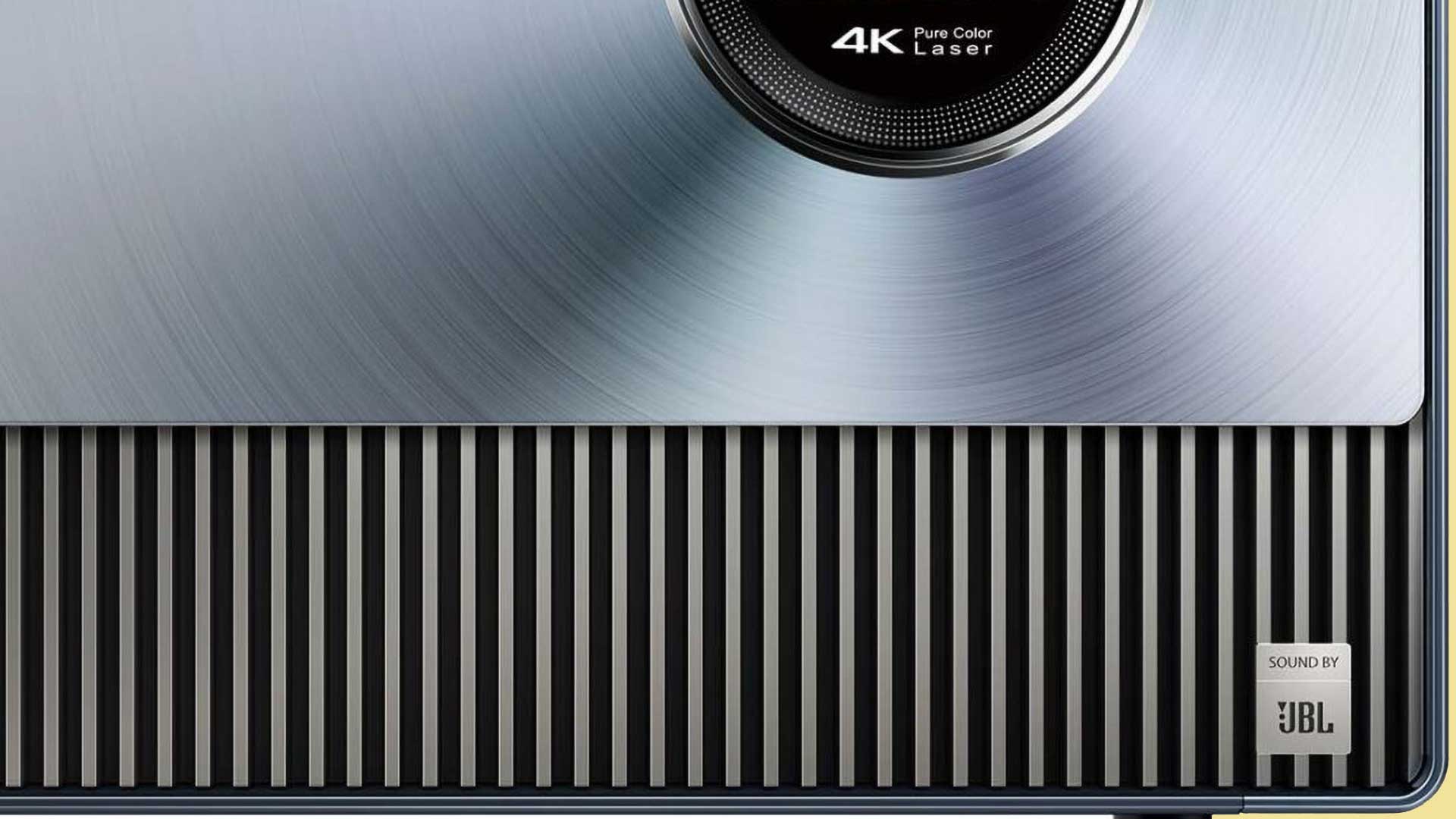
Sound system
There’s also Dolby Atmos audio decoding here, though of course multichannel material is folded down to the stereo of the speakers (give or take any pseudo-surround from the JBL-tuned speaker complement). But oddly you can turn Dolby Atmos on or off in the audio control section, apparently regardless of whether Dolby Atmos is being received. In this regard its effect seems very like the ‘movie’ sound mode, which spreads and beefs up the sound from the JBL speakers a little more than the clean ‘Normal’ mode. This ‘movie’ sound is good at lowish levels but gets mighty boomy if you turn it up; ‘Standard’ is then your best bet. It’s great that Hisense has given both the ‘sound mode’ and ‘picture mode’ dedicated buttons on the remote control; it saves putting so many menus up on screen when tweaking.
Not only are there sound modes to tweak the speaker output, you can tweak the modes to try its various Dolby and DTS modes, adjusting the ‘surround’ effect, bass boost, dialogue clarity, it’s all here, even a field marked ‘Total Sonics’ (to “optimise the overall sound quality by increasing bass and widening the sound field to provide a clear, natural dialogue”).
Having said that, the sound is still coming from a box in the wrong place. An external sound system will make the best of your bigscreen images, and the C1 has excellent control over exactly what audio goes out via HDMI ARC or optical: choose from auto, passthrough, PCM, or Dolby Audio via either DD or DD+ containers. Via HDMI-CEC there’s a good chance you’ll also be able to control a connected soundbar (say) using the Hisense’s remote control.
Sound system aside, we should also mention how very quiet this C1 is otherwise; no colour-wheel whirr, no fan noise we could hear, even when sitting close.
That E-manual, once we had found it, told us of more abilities. The remote control has a microphone and button for voice commands. There’s Bluetooth in and out, the former for playback from mobile devices, even a keyboard and mouse, and the latter for use with Bluetooth headphones and speakers; very handy.
You can screen-share from a PC, or use AirPlay for both video and audio from a Mac. You can even control the projector via HomeKit on a mobile device. We like that you can even tweak exactly how fast the picture turns off with a ‘curtain close’ when you put the projector into standby. Nice. Thoughtful.

Verdict
We do wish that the 'E-manual' came in the box, as it really highlights and opens up the level of control that Hisense offers here to tweakers, over and above the initial presentation of the C1 as a projector which just takes care of most things on its own. It does that very well, and you can then build on the built-in smarts by tweaking settings and adding external sources.
That all makes the C1 a versatile small (if not quite mini) projector, further marked out by its premium build quality and overall solid image performance at the price.

Jez is the Editor of Sound+Image magazine, having inhabited that role since 2006, more or less a lustrum after departing his UK homeland to adopt an additional nationality under the more favourable climes and skies of Australia. Prior to his desertion he was Editor of the UK's Stuff magazine, and before that Editor of What Hi-Fi? magazine, and before that of the erstwhile Audiophile magazine and of Electronics Today International. He makes music as well as enjoying it, is alarmingly wedded to the notion that Led Zeppelin remains the highest point of rock'n'roll yet attained, though remains willing to assess modern pretenders. He lives in a modest shack on Sydney's Northern Beaches with his Canadian wife Deanna, a rescue greyhound called Jewels, and an assortment of changing wildlife under care. If you're seeking his articles by clicking this profile, you'll see far more of them by switching to the Australian version of WHF.
